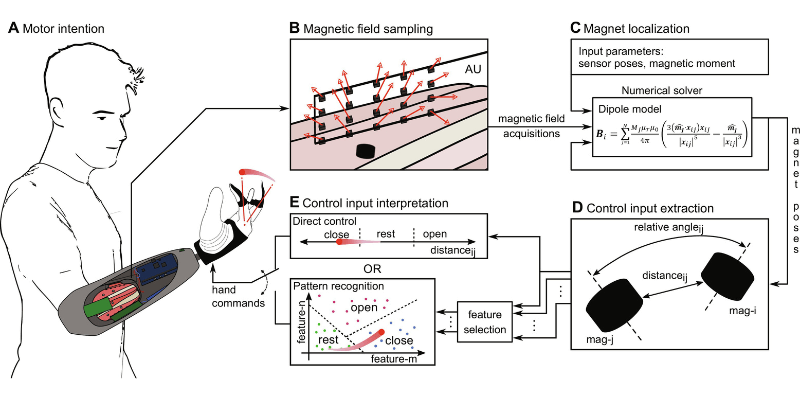Create your CubeMars account

A New Approach to Bionic Arm Control: Magnetic Implants Restore Dexterous Grasp Function

In recent years, bionic arm technology has made remarkable strides. A recent groundbreaking study has introduced an innovative prosthesis control method based on a Myokinetic Interface. This cutting-edge technology leverages muscle contractions to detect the displacement of implanted magnets, offering a novel control mechanism for amputees. This research not only demonstrates the clinical feasibility of the technology but also sets the stage for future exploration in human-robot interaction.
Technological Breakthrough and Innovation
The core idea of the Myokinetic Interface is to capture the physical displacement of muscle contractions through implanted magnets to decode user intent. The research team implanted six small neodymium magnets into the residual limb of the participant and developed a fully autonomous prosthesis system. This system includes all hardware components and batteries housed within the prosthesis chamber, using changes in magnet positions to control the dexterous robotic hand in real-time.
In the implementation, the team selected the flexor carpi ulnaris (FCU), extensor digitorum (ED), and flexor pollicis longus (FPL) muscles as the target sites for magnet implantation. The implanted neodymium magnets, each 2 mm in diameter, were coated with a medical-grade material. Regular ultrasound imaging was used to monitor the stability of the magnet displacement during muscle contractions, which is crucial for accurate prosthesis control.
To facilitate prosthesis control, the team developed a percutaneous magnet locator (TML), which tracks the position and orientation of the magnets in real-time using sensor grids within the prosthesis chamber. This data is used as input for the myokinetic controller, which processes the signals and converts them into commands for the robotic hand. Two control strategies—direct control and pattern recognition—were employed to validate the system's effectiveness.
Clinical Applications and Limitations
The clinical application of this technology highlights the unique advantages of the Myokinetic Interface. Compared to traditional myoelectric control methods, this technology offers several significant benefits:
1. Reduced Infection Risk: The implanted magnets do not require wireless power or percutaneous leads, lowering the risk of infection and long-term stability issues.
2. Precise Control: The smaller size of the magnets allows for implantation in more muscle sites, theoretically enabling more degrees of control.
3. Direct Measurement: Magnet displacement provides direct measurements of muscle length and speed, which helps to more accurately correlate muscle activation with strength.
However, there are also challenges associated with the implementation of this technology. For instance, elbow movements can affect the relative position of the magnets, increasing the complexity of signal processing. The research team overcame some of these issues through clever algorithm design and an enable/disable switch to avoid false triggers caused by elbow movement.
Future Development and Challenges
This pioneering research points the way for further development of the Myokinetic Interface. Future work should focus on:
1. Biomechanical Research: Investigating the biomechanics of muscle contraction and tissue deformation to optimize magnet placement and quantity.
2. Surgical Technique Improvement: Enhancing surgical techniques and magnet design to maximize signal quality and minimize tissue reaction.
3. Signal Processing Optimization: Developing more advanced signal processing and machine learning algorithms to extract more information from limited input signals and achieve multi-degree-of-freedom control.
Long-term clinical trials are also essential. Although the 6-week study did not reveal any significant adverse effects, the safety and stability of long-term magnet implantation need further evaluation. Additionally, understanding patients' adaptation to and long-term experience with this new interface is crucial.
The Myokinetic Interface represents a new frontier in prosthesis control technology. This approach shows immense potential not only for providing amputees with more intuitive and flexible control over their prostheses but also for exploring new pathways in human-robot interaction. With ongoing advancements in technology, we can anticipate that this magnet-based prosthesis control system will bring significant benefits to more patients in the near future, helping them regain lost functions and improve their quality of life.